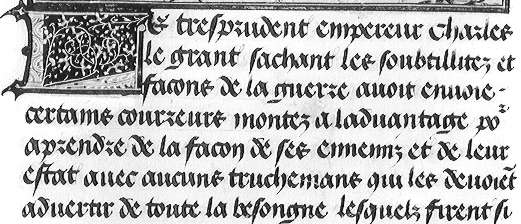Script Type : minuscule
Alternative Name : lettres de forme
Date : 15th century
Location : France and the Low Countries
Function : Book hand of formal grade


























Distinctive letters : This large and elegant script called bâtarde, or lettres de forme, is somewhat different to the English bastarda scripts, although deriving from a similar union of book hands and document hands. The letters are angular, and sometimes conjoined, as in Gothic textura, but the distinctive ascenders and descenders of f and the long form of s are curved and tapering. While it has some cursive qualities, as some letters appear to be joined, it is a formal and carefully written script. The short form of s is fully closed, as is found in French cursive scripts of this date. Although the letters are angular, there are no rows of minims, as some ends of letters end in a tapered point rather than with feet or an upward kink, so that the letters m, n, i and u are easily distinguished.
As usual, there is no distinction between u and v. There are two forms of r, including the simplified form found after vowels, but here the two forms are used together when the letter is doubled in a word, as in guerre or courreurs.
There are no examples of j, k or w in this sample.
It might be noted that French still does not employ accents on letters at this date.
This style of writing was used for some early printed books. Pass the cursor slowly along the first few lines for a taste, and to investigate further, proceed to the paleography exercises.
Paleography
exercises using Flash ![]()
Requires at least the Flash 5 plugin
If you are looking at this page without frames, there is more information about medieval writing to be found by going to the home page (framed) or the site map (no frames).